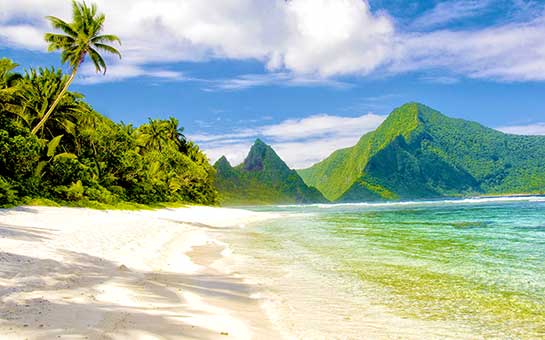American Samoa consists of five volcanic islands and two atolls in the South Pacific Ocean. Located between Hawaii and New Zealand, American Samoa is an unincorporated U.S. territory. The residents of these islands are U.S. nationals, but not U.S. citizens.
American Samoa belongs to the Samoan archipelago. It lies about 100 kilometers (about 60 miles) to the east of the independent country Samoa.
American Samoa does not rank high on lists of international tourism destinations. But the islands merit a visit for their incredible scenic beauty, exposure to the traditional Polynesian culture, and stunning rainforest treks.
The climate is warm, humid, and rainy throughout the year. April to September is marginally cooler and drier than October to March.
American Samoa is a safe country with crime rates considerably lower than in some of the other South Pacific islands. However, despite this, you should be sure to purchase visitors insurance as a safety net should the worst occur.
American Samoa Travel Medical Insurance for International Travelers - FAQs
Do I need travel medical insurance for American Samoa?
If you are a U.S. citizen with an original Medicare plan, be aware that this plan is valid in American Samoa. Other U.S. domestic health insurance plans may not be; check with your provider. Citizens from most other countries should purchase travel medical insurance to save money on any potential out-of-pocket medical costs they might incur when there.
Why buy travel medical insurance for American Samoa?
We've already shared the list of common infectious diseases in American Samoa. You should get all of the appropriate vaccines before you travel.
However, vaccines protect you against any of these infections turning critical, but not from getting infected. Also, vaccines are not available for all the diseases prevalent there.
There's no vaccine against possible insect bites, a twisted ankle, or a fracture from a fall during a hike, either. It is practical to get travel medical insurance in American Samoa to cover the risks inherent to the activities you'll likely undertake.
The hazards you might face in American Samoa are considerable. The right choice is to buy visitors medical insurance and enjoy your vacation with one less thing to worry about.
Things to Do for Travelers in American Samoa
If you are planning a trip to American Samoa, try to give it enough time to visit as many of the islands as you can. Tutuila, Aunu'u, Ofu, Olosega, and Ta'u are the five main islands, and Rose and Swain are the atolls. Ideally, two weeks will allow you to sufficient time to absorb everything the islands have to offer.
U.S. citizens don't need a visa to travel to American Samoa, but they do need to carry their passports. Citizens of several other countries are also eligible for visa waiver programs. Check out the immigration website of American Samoa.
Visit the National Park of American Samoa
As an international traveler, you're most likely to arrive at Tutuila, the main island. Both the international airport and the capital city of Pago Pago are here. Start by visiting the Tutuila part of the National Park of American Samoa, home to the endangered fruit bats, aka flying foxes. There are both beginner-level and more challenging hiking options you can check out.
Take a Guided Trip to the Volcanoes
Enjoy the sheer thrill of visiting dormant volcanoes teeming with wildlife. This trip will also allow you to experience and absorb traditional Samoan culture.
Relax on the Ofu Beach
The major part of the National Park lies in the Manua Islands, the collective name for the islands of Ofu, Olosega, and Ta'u. Don't miss relaxing on the stunningly beautiful Ofu beach, also within the National Park.
Make a Day Trip to Aunu'u
Hop into a ferry from the eastern end of Tutuila, and enjoy your day at Aunu'u. Do ensure that you don't miss the last boat back.
Experience Vaitogi
Move away from the captivating beaches to visit the rocky cliffs of Vaitogi. You'll feel enriched listening to the tale of the Turtle and the Shark, the Samoan archipelago's most famous legend.
Travel Risks for International Travelers in American Samoa
- Several water-borne and vector-borne infections are common in American Samoa. That includes the active transmission of the Zika virus. Chikungunya and dengue are prevalent, too.
- The U.S. Centers for Disease Control and Prevention (CDC) strongly recommends getting vaccines for malaria, typhoid, and hepatitis A, B, and E before your trip.
- Treks through the rainforest and along rocky cliffs are some of the most popular activities in American Samoa. It's impossible to rule out risks like insect bites and accidental trips and falls.
- American Samoa is perpetually at risk of natural hazards like cyclones and earthquakes. Any such natural disaster may require you to cancel or cut your trip short.
- The crime rate is low, but petty crimes are common. To get travel insurance that covers losses incurred due to a situation like being pickpocketed or having your purse stolen is a wise step.
Before You Travel to American Samoa - Do This
- Remember to carry modest beachwear. American Samoa is conservative.
- Pack sufficient sunscreen lotion and insect repellents.
